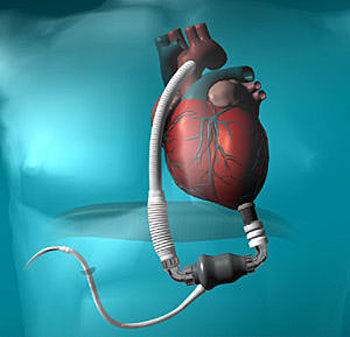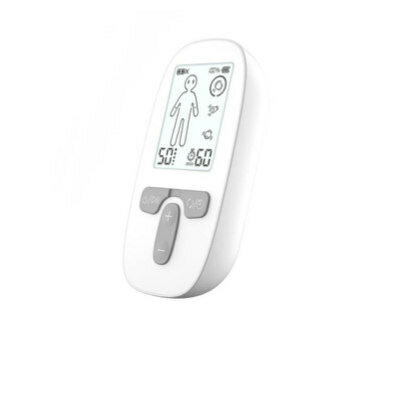LVAD Survival Better When Combined with ICD
|
By HospiMedica International staff writers Posted on 19 Jul 2016 |

Image: According to a new study, patient survival with a left ventricular assist device (LVAD) is better when an implantable cardioverter defibrillator (ICD) is also present (Photo courtesy of BCM).
Researchers at the Minneapolis Veterans Affairs (VA) Health Care System (MN, USA) conducted a systematic review and meta-analysis of studies published in PubMed and OVID databases from January 2000 through October 2015 in order to evaluate the impact of ICDs on mortality in patients with LVADs. In all, six relevant studies were identified, which included 937 patients (mean age 53 years, 80% male). A continuous-flow LVAD was present in 39% of the patients, and an ICD was present in 38%.
The results showed that among LVAD patients, all-cause mortality rates were 16% with an ICD, versus 32% without one, over a mean follow-up period of 7 months. Patients with newer, continuous flow LVADs showed a similar, but non-significant trend for better survival with an ICD (14% versus 25%, respectively). The authors acknowledged that they failed to totally exclude patients with biventricular assist devices (17%) and right ventricular assist devices (4%). The study was published in the July 2016 issue of JACC: Heart Failure.
“The evidence supporting ICD use in patients with LVADs is limited to a few, relatively small studies. Current practice guidelines supporting ICD use in LVAD patients are therefore predominantly based on expert consensus and observational studies,” wrote lead author Kairav Vakil, MD, and colleagues, adding that, “this cohort was enriched with patients that received an LVAD as bridge-to-transplantation. As such, these results cannot be generalized to patients receiving destination therapy LVADs, who are known to be relatively sicker than those awaiting transplantation.”
An LVAD is intended to complement a weakened heart by providing circulatory support. Surgically implanted in proximity to the heart, one end is attached to the left ventricle, while the other is attached to the aorta. Blood flows from the ventricles into the pump and is then ejected out of the device and into the aorta. Although the mechanism of survival benefit from ICDs in LVAD patients remains unclear, a possible explanation is that it may contribute to a reduction in harmful effects of ventricular arrhythmias on right ventricular function, thereby leading to reduction of heart failure deaths.
Related Links:
Minneapolis Veterans Affairs
The results showed that among LVAD patients, all-cause mortality rates were 16% with an ICD, versus 32% without one, over a mean follow-up period of 7 months. Patients with newer, continuous flow LVADs showed a similar, but non-significant trend for better survival with an ICD (14% versus 25%, respectively). The authors acknowledged that they failed to totally exclude patients with biventricular assist devices (17%) and right ventricular assist devices (4%). The study was published in the July 2016 issue of JACC: Heart Failure.
“The evidence supporting ICD use in patients with LVADs is limited to a few, relatively small studies. Current practice guidelines supporting ICD use in LVAD patients are therefore predominantly based on expert consensus and observational studies,” wrote lead author Kairav Vakil, MD, and colleagues, adding that, “this cohort was enriched with patients that received an LVAD as bridge-to-transplantation. As such, these results cannot be generalized to patients receiving destination therapy LVADs, who are known to be relatively sicker than those awaiting transplantation.”
An LVAD is intended to complement a weakened heart by providing circulatory support. Surgically implanted in proximity to the heart, one end is attached to the left ventricle, while the other is attached to the aorta. Blood flows from the ventricles into the pump and is then ejected out of the device and into the aorta. Although the mechanism of survival benefit from ICDs in LVAD patients remains unclear, a possible explanation is that it may contribute to a reduction in harmful effects of ventricular arrhythmias on right ventricular function, thereby leading to reduction of heart failure deaths.
Related Links:
Minneapolis Veterans Affairs
Latest Critical Care News
- Bioadhesive Strategy Prevents Fibrosis Around Device Implants on Peripheral Nerves
- Miniature Non-Invasive Robotic Catheters to Improve Infertility Treatments
- Stick-On Patch Monitors Baby's Movements In Utero
- EEG-Based AI Technology Accurately Diagnoses Alzheimer’s and Dementia
- Robot Lymphatic System Paves Way for Self-Powered Wearables and Machines
- Focused Ultrasound Technique Successfully Treats Pediatric Brain Cancer
- Nasal Drops Fight Brain Tumors Noninvasively
- AI Helps Optimize Therapy Selection and Dosing for Septic Shock
- Glowing Bacteria ‘Pills’ for Detecting Gut Diseases Could Eliminate Colonoscopies
- Skin-Permeable Polymer Patch Delivers Insulin Non-Invasively Through Skin
- Nanogel Technology Almost 100% Effective in Destroying Drug-Resistant Bacteria Within Hours
- Wearable Ultrasound Sensor Delivers Noninvasive Treatment Without Surgery
- Gel-Free ECG System to Transform Heart Health Diagnosis
- Biodegradable Patch Repairs Damaged Tissue After Heart Attack
- Magnetically Guided Microrobots to Enable Targeted Drug Delivery

- Smart Nanomaterials Detect and Treat Traumatic Brain Injuries Simultaneously
Channels
Surgical Techniques
view channel
Catheter-Based Procedures Offer Less Invasive Option for Treatment of Valvular Disease
Valvular heart disease, caused by tight or leaky valves between heart chambers, affects up to 10% of older adults and leads to more than 120,000 deaths globally each year. Traditional open-heart surgery... Read moreLaparoscopic Surgery Improves Outcomes for Severe Newborn Liver Disease
Biliary atresia is a rare but life-threatening liver condition in newborns that blocks bile flow and leads to progressive liver damage if not treated early. Surgery is typically performed within the first... Read morePatient Care
view channel
Revolutionary Automatic IV-Line Flushing Device to Enhance Infusion Care
More than 80% of in-hospital patients receive intravenous (IV) therapy. Every dose of IV medicine delivered in a small volume (<250 mL) infusion bag should be followed by subsequent flushing to ensure... Read more
VR Training Tool Combats Contamination of Portable Medical Equipment
Healthcare-associated infections (HAIs) impact one in every 31 patients, cause nearly 100,000 deaths each year, and cost USD 28.4 billion in direct medical expenses. Notably, up to 75% of these infections... Read more
Portable Biosensor Platform to Reduce Hospital-Acquired Infections
Approximately 4 million patients in the European Union acquire healthcare-associated infections (HAIs) or nosocomial infections each year, with around 37,000 deaths directly resulting from these infections,... Read moreFirst-Of-Its-Kind Portable Germicidal Light Technology Disinfects High-Touch Clinical Surfaces in Seconds
Reducing healthcare-acquired infections (HAIs) remains a pressing issue within global healthcare systems. In the United States alone, 1.7 million patients contract HAIs annually, leading to approximately... Read moreHealth IT
view channel
EMR-Based Tool Predicts Graft Failure After Kidney Transplant
Kidney transplantation offers patients with end-stage kidney disease longer survival and better quality of life than dialysis, yet graft failure remains a major challenge. Although a successful transplant... Read more
Printable Molecule-Selective Nanoparticles Enable Mass Production of Wearable Biosensors
The future of medicine is likely to focus on the personalization of healthcare—understanding exactly what an individual requires and delivering the appropriate combination of nutrients, metabolites, and... Read moreBusiness
view channel
Philips and Masimo Partner to Advance Patient Monitoring Measurement Technologies
Royal Philips (Amsterdam, Netherlands) and Masimo (Irvine, California, USA) have renewed their multi-year strategic collaboration, combining Philips’ expertise in patient monitoring with Masimo’s noninvasive... Read more
B. Braun Acquires Digital Microsurgery Company True Digital Surgery
The high-end microsurgery market in neurosurgery, spine, and ENT is undergoing a significant transformation. Traditional analog microscopes are giving way to digital exoscopes, which provide improved visualization,... Read more
CMEF 2025 to Promote Holistic and High-Quality Development of Medical and Health Industry
The 92nd China International Medical Equipment Fair (CMEF 2025) Autumn Exhibition is scheduled to be held from September 26 to 29 at the China Import and Export Fair Complex (Canton Fair Complex) in Guangzhou.... Read more














